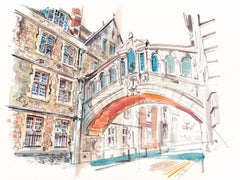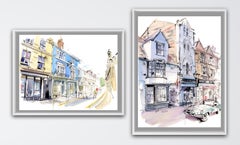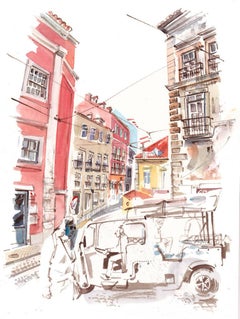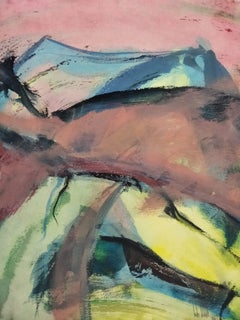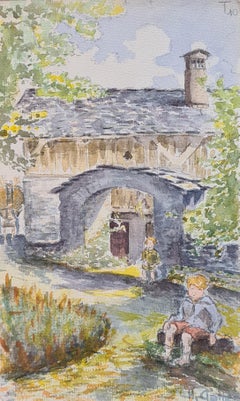Gary Wing Art
to
4
3
1
3
1
Overall Height
to
Overall Width
to
2
1
3
2
2
2
2
1
1
1
1
1
1
4
4
6,886
3,210
2,514
1,217
3
2
2
2
2
Artist: Gary Wing
Bridge of Sighs II, Giclee print, Oxford, Architecture, bridge
By Gary Wing
Located in Deddington, GB
Bridge of Sighs II by Gary Wing Limited edition print by Gary Wing, featuring the iconic Hertford Bridge in Oxford, also known as the Bridge of Sighs. Original work also available. S...
Category
2010s Contemporary Gary Wing Art
Materials
Giclée
Turl Street and St Giles Café Diptych
By Gary Wing
Located in Deddington, GB
Turl Street and St Giles Café Diptych
Overall Size cm : H48 x W56
Turl Street by Gary Wing
Limited edition print by Gary Wing depicting a daytime scene on T...
Category
2010s Impressionist Gary Wing Art
Materials
Paper, Giclée
Gary Wing, Lisbon Street, Original Architectural Painting, Affordable Art
By Gary Wing
Located in Deddington, GB
Gary Wing
Lisbon Street
Original Cityscape Painting
Watercolour Pain on Paper
Sheet Size: H 29.7cm x W 21cm x D 0.01cm
Sold Unframed
Please note that in situ images are purely an ind...
Category
21st Century and Contemporary Impressionist Gary Wing Art
Materials
Paper, Watercolor
Lisbon Street BY GARY WING, Architectural Art, Watercolour Painting, Traditional
By Gary Wing
Located in Deddington, GB
Gary Wing
An A4 watercolour of a Lisbon Street on paper.
Category
21st Century and Contemporary Gary Wing Art
Materials
Paper, Watercolor
Related Items
Untitled
Located in Barcelona, ES
Includes a Certificate of Authenticity
Category
1980s Post-Modern Gary Wing Art
Materials
Acrylic, Watercolor, Gouache, Paper, Handmade Paper
1930s French Impressionist Watercolour of Children in an Idyllic Country Scene
Located in Cotignac, FR
French Impressionist watercolour on paper view of children in an idyllic country scene by Henri Clamen. Signed bottom right. Acquired from the atelier of the artist with other signed...
Category
Early 20th Century Impressionist Gary Wing Art
Materials
Paper, Ink, Watercolor
La Vue - Juan les Pins - 19th Century Watercolor, Flowers by Sea Landscape Duhem
By Henri Duhem
Located in Marlow, Buckinghamshire
Watercolour on paper circa 1925 by Henri Duhem depicting a view of the sea from the promenade at Juan les Pins on the French Riviera. A flower box of pur...
Category
Early 20th Century Impressionist Gary Wing Art
Materials
Watercolor, Paper
Steelheaders Are Born That Way - Landscape
By Robert E. Eddy
Located in Soquel, CA
Moody, atmospheric landscape watercolor of fishermen at dawn by listed artist Robert "Bob" Eddy (American, 1908-2008). Titled lower left: "Steelheaders Are Born That Way." Signed by ...
Category
1980s American Impressionist Gary Wing Art
Materials
Paper, Watercolor
Study for "Notre Dame" - 19th Century Oil, Boats & Figures on River by M Luce
By Maximilien Luce
Located in Marlow, Buckinghamshire
Oil on paper laid on canvas. Signed & dated 1899 lower right.
This work is included in Tome II of the Catalogue Raisonne by Denise Bazetoux- Ref: 159
This work is a plein air stud...
Category
1890s Impressionist Gary Wing Art
Materials
Paper, Oil, Canvas
H 12.5 in W 9.5 in D 1 in
Boats at Sunset, Original Gouache on Paper, Impressionist style, French Painter
Located in PARIS, FR
*Dimensions include the frame
This French watercolor dating from around 1930 conveys a serene maritime scene that resonates with the aesthetic principles of the Impressionists. The ...
Category
1930s Impressionist Gary Wing Art
Materials
Gouache, Laid Paper
H 11.03 in W 13 in D 1.58 in
"Train Station, " Max Kuehne, Industrial City Scene, American Impressionism
By Max Kuehne
Located in New York, NY
Max Kuehne (1880 - 1968)
Train Station, circa 1910
Watercolor on paper
8 1/4 x 10 1/4 inches
Signed lower right
Provenance:
Private Collection, Illinois
Max Kuehne was born in Halle, Germany on November 7, 1880. During his adolescence the family immigrated to America and settled in Flushing, New York. As a young man, Max was active in rowing events, bicycle racing, swimming and sailing. After experimenting with various occupations, Kuehne decided to study art, which led him to William Merritt Chase's famous school in New York; he was trained by Chase himself, then by Kenneth Hayes Miller. Chase was at the peak of his career, and his portraits were especially in demand. Kuehne would have profited from Chase's invaluable lessons in technique, as well as his inspirational personality. Miller, only four years older than Kuehne, was another of the many artists to benefit from Chase's teachings. Even though Miller still would have been under the spell of Chase upon Kuehne's arrival, he was already experimenting with an aestheticism that went beyond Chase's realism and virtuosity of the brush. Later Miller developed a style dependent upon volumetric figures that recall Italian Renaissance prototypes.
Kuehne moved from Miller to Robert Henri in 1909. Rockwell Kent, who also studied under Chase, Miller, and Henri, expressed what he felt were their respective contributions: "As Chase had taught us to use our eyes, and Henri to enlist our hearts, Miller called on us to use our heads." (Rockwell Kent, It's Me O Lord: The Autobiography of Rockwell Kent. New York: Dodd, Mead and Co., 1955, p. 83). Henri prompted Kuehne to search out the unvarnished realities of urban living; a notable portion of Henri's stylistic formula was incorporated into his work.
Having received such a thorough foundation in art, Kuehne spent a year in Europe's major art museums to study techniques of the old masters. His son Richard named Ernest Lawson as one of Max Kuehne's European traveling companions. In 1911 Kuehne moved to New York where he maintained a studio and painted everyday scenes around him, using the rather Manet-like, dark palette of Henri.
A trip to Gloucester during the following summer engendered a brighter palette. In the words of Gallatin (1924, p. 60), during that summer Kuehne "executed some of his most successful pictures, paintings full of sunlight . . . revealing the fact that he was becoming a colorist of considerable distinction." Kuehne was away in England the year of the Armory Show (1913), where he worked on powerful, painterly seascapes on the rocky shores of Cornwall. Possibly inspired by Henri - who had discovered Madrid in 1900 then took classes there in 1906, 1908 and 1912 - Kuehne visited Spain in 1914; in all, he would spend three years there, maintaining a studio in Granada. He developed his own impressionism and a greater simplicity while in Spain, under the influence of the brilliant Mediterranean light. George Bellows convinced Kuehne to spend the summer of 1919 in Rockport, Maine (near Camden). The influence of Bellows was more than casual; he would have intensified Kuehne's commitment to paint life "in the raw" around him.
After another brief trip to Spain in 1920, Kuehne went to the other Rockport (Cape Ann, Massachusetts) where he was accepted as a member of the vigorous art colony, spearheaded by Aldro T. Hibbard. Rockport's picturesque ambiance fulfilled the needs of an artist-sailor: as a writer in the Gloucester Daily Times explained, "Max Kuehne came to Rockport to paint, but he stayed to sail." The 1920s was a boom decade for Cape Ann, as it was for the rest of the nation. Kuehne's studio in Rockport was formerly occupied by Jonas Lie.
Kuehne spent the summer of 1923 in Paris, where in July, André Breton started a brawl as the curtain went up on a play by his rival Tristan Tzara; the event signified the demise of the Dada movement. Kuehne could not relate to this avant-garde art but was apparently influenced by more traditional painters — the Fauves, Nabis, and painters such as Bonnard. Gallatin perceived a looser handling and more brilliant color in the pictures Kuehne brought back to the States in the fall. In 1926, Kuehne won the First Honorable Mention at the Carnegie Institute, and he re-exhibited there, for example, in 1937 (Before the Wind). Besides painting, Kuehne did sculpture, decorative screens, and furniture work with carved and gilded molding. In addition, he designed and carved his own frames, and John Taylor Adams encouraged Kuehne to execute etchings. Through his talents in all these media he was able to survive the Depression, and during the 1940s and 1950s these activities almost eclipsed his easel painting. In later years, Kuehne's landscapes and still-lifes show the influence of Cézanne and Bonnard, and his style changed radically.
Max Kuehne died in 1968. He exhibited his work at the National Academy of Design, the Art Institute of Chicago, the Carnegie Institute in Pittsburgh, the Memorial Art Gallery of the University of Rochester, and in various New York City galleries. Kuehne's works are in the following public collections: the Detroit Institute of Arts (Marine Headland), the Whitney Museum (Diamond Hill...
Category
1910s American Impressionist Gary Wing Art
Materials
Paper, Watercolor
Burnt Ocean Waters, Abstract Diptych, Golden Yellow Pink, Mediterranean Seascape
By Ryan Rivadeneyra
Located in Barcelona, ES
Cyd Fontaine (Lausanne, 1992) is a contemporary artist renowned for her captivating use of dreamy atmospheric gradients, which has helped her carve a distinctive niche in the world o...
Category
2010s Contemporary Gary Wing Art
Materials
Photographic Film, Archival Ink, Photographic Paper, C Print, Digital, G...
Free Shipping
H 36 in W 48 in
"Monhegan Island, Maine, " Edward Dufner, American Impressionism Landscape View
By Edward Dufner
Located in New York, NY
Edward Dufner (1872 - 1957)
Monhegan Island, Maine
Watercolor on paper
Sight 16 x 20 inches
Signed lower right
With a long-time career as an art teacher and painter of both 'light' and 'dark', Edward Dufner was one of the first students of the Buffalo Fine Arts Academy to earn an Albright Scholarship to study painting in New York. In Buffalo, he had exchanged odd job work for drawing lessons from architect Charles Sumner. He also earned money as an illustrator of a German-language newspaper, and in 1890 took lessons from George Bridgman at the Buffalo Fine Arts Academy.
In 1893, using his scholarship, Dufner moved to Manhattan and enrolled at the Art Students League where he studied with Henry Siddons Mowbray, figure painter and muralist. He also did illustration work for Life, Harper's and Scribner's magazines.
Five years later, in 1898, Dufner went to Paris where he studied at the Academy Julian with Jean-Paul Laurens and privately with James McNeill Whistler. Verification of this relationship, which has been debated by art scholars, comes from researcher Nancy Turk who located at the Smithsonian Institution two 1927 interviews given by Dufner. Turk wrote that Dufner "talks in detail about Whistler, about how he prepared his canvasas and about numerous pieces he painted. . . A great read, the interview puts to bed" the ongoing confusion about whether or not he studied with Whistler.
During his time in France, Dufner summered in the south at Le Pouleu with artists Richard Emil Miller...
Category
Early 20th Century American Impressionist Gary Wing Art
Materials
Paper, Watercolor
Ben Harman - The Lion King - Contemporary Cinema Film Movie Posters
Located in Asheville, NC
The Lion King
Disney Animation Film
The Lion King is a 1994 American animated musical drama film produced by Walt Disney Feature Animation and released by Walt Disney Pictures. It is the 32nd Disney animated feature film, and the fifth animated film produced during a period known as the Disney Renaissance. The Lion King was directed by Roger Allers and Rob Minkoff, produced by Don Hahn, and has a screenplay credited to Irene Mecchi, Jonathan Roberts, and Linda Woolverton. Its original songs were written by composer Elton John and lyricist Tim Rice, with a score by Hans Zimmer. The film features an ensemble voice cast that includes Matthew Broderick, James Earl Jones, Jeremy Irons, Jonathan Taylor Thomas, Moira Kelly, Nathan Lane, Ernie Sabella, Rowan Atkinson, Robert Guillaume, Madge Sinclair (in her last film role), Whoopi Goldberg, Cheech Marin, and Jim Cummings. The story takes place in a kingdom of lions in Africa and was influenced by the Biblical stories of Joseph and Moses, and William Shakespeare's Hamlet.
Artists: Ben Harman...
Category
2010s Contemporary Gary Wing Art
Materials
Giclée, Color, Archival Pigment, Screen
Homestead, Regional American Landscape by Pennsylvania Impressionist
By Harry Leith-Ross
Located in Doylestown, PA
"Homestead" is a regional, American landscape by Pennsylvania Impressionist and New Hope School painter Harry Leith-Ross. The painting is a 14" x 19" watercolor on paper, signed "Lei...
Category
1940s American Impressionist Gary Wing Art
Materials
Watercolor, Archival Paper
H 23.5 in W 29 in D 1.5 in
A Gaucho and His Horse - Gouache On Paper Brazilian Cowboy on the Plains
Located in Soquel, CA
A Cowboy And His Horse - Gouache On Paper
Gouache on paper painting depicting a cowboy and his horse by a campfire by Reinaldo Manzke (Brazilian, 1906-1980). A cowboy is seen sittin...
Category
Mid-20th Century Impressionist Gary Wing Art
Materials
Paper, Gouache
Gary Wing art for sale on 1stDibs.
Find a wide variety of authentic Gary Wing art available for sale on 1stDibs. You can also browse by medium to find art by Gary Wing in paper, paint, watercolor and more. Much of the original work by this artist or collective was created during the 21st century and contemporary and is mostly associated with the Impressionist style. Not every interior allows for large Gary Wing art, so small editions measuring 9 inches across are available. Customers who are interested in this artist might also find the work of Frederick George Cotman, Noel Howard, and Brian Rounds. Gary Wing art prices can differ depending upon medium, time period and other attributes. On 1stDibs, the price for these items starts at $242 and tops out at $774, while the average work can sell for $774.
